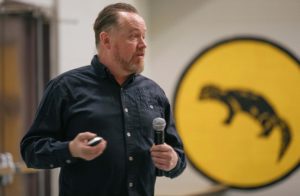‘It’s about the fish, the lake, and our environment’ says Nipissing First Nation Chief

By Kelly Anne Smith
NIPISSING FIRST NATION—Lake Nipissing generates $100 million dollars a year but only recently has Nipissing First Nation benefitted economically from its own lake. With a recent near-crisis avoided with positive signs in the fishery, Nipissing First Nation’s Chief sees a healthy lake in the future.
Chief Scott McLeod gave a presentation recently to inform the community about the fishery. It was part of the Fish-WIKS 5-year research project summary for the community of Nipissing First Nation. An afternoon session focused on the Elders and then an open session in the evening for everyone else.
Nicole Latulippe, Ph.D. and Masters student, and Lisa Blenkinsop worked as researchers on the project with Nipissing First Nation citizens. Fish-WIKS strives to understand how Indigenous and Western knowledge systems can improve the sustainability of Canadian fisheries.
The Chief was pleased with how the project gave back.
“Part of their work includes bringing back the results of that research to the community. I also wanted to share some of the work that our fisheries department had been doing over the years, plus some historical background. Many of the participants there could have been involved in the study. It was bringing back to them, what the interpretation was that the researchers heard right from those comments.”
With special guest Ontario Regional Chief Isadore Day in attendance, Chief McLeod spoke of the fish laws.
“Not so much what’s in the fish laws but Nipissing First Nation’s history and how we used to have laws prior to contact and then how the ‘settling’ government affected us and our ability and how we are trying to get back on track. Now we are using the laws to protect our inherent rights and rights to the resources.”
Chief McLeod says he sees the light go on in many people who see his presentation.
“Sometimes even the Elders are not sure exactly because some of it is fairly complex as to why we are doing what we are doing; why we have laws; what the laws mean; and what we are trying to achieve. I spell it out and I talk from the days far gone of when we had our own clan governance systems and our own sovereignty, to the impacts after the signing of the Treaty [Robinson Huron Treaty]. There has been almost a century of oppression and poverty. We are trying to get back to those days when we were a strong healthy community with a strong and structured sovereign government. [The Elders] start to see the bigger picture and understand where we are heading and what our visions are. They fully understand now what we are trying to do.”
The Chief was most concerned with people understanding what was really happening with Lake Nipissing.
“Three years ago, seemingly, there were a lot of fish. But the problem was all the fish were immature. Any pressure, whether it was Indigenous harvesting or non-indigenous harvesting, showed they were not harvesting adult fish and there was not a lot left of adult fish.”
Chief McLeod compares the problem with what happened with the East Coast cod fishery back in the 80s and 90s.
“We humans were starting to harvest them before they reached their maturity to spawn. It was a large population of immature fish that were not of spawning age… So essentially, we had a good population of young fish, but we kept harvesting them each year, and they were not getting to the point of maturity, therefore the end of the line was coming, which is what happened with the cod stocks… It was a complex situation to understand. When you put your hook, line or net in the water, you would catch fish. The automatic conclusion was there was lots of fish, but that wasn’t the case.”
The Chief reports improvements.
“In the three years since we have implemented the measures to help protect those fish to reach maturity age, is that we are starting to see larger fish in the surveys that we do, meaning that they are starting to grow to that age where they can reproduce. And last year we started to see more adult mature fish reaching the spawning shoals. Although we are not out of the woods, we kind of averted disaster. The imminent collapse of the fishery— we’ve staved off.”
Chief McLeod urges vigilance on allowing fish to spawn.
“Our work is not done but I’m happy and encouraged by all the positive signs that the fishery is showing. It’s heading away from disaster and into recovery.”

